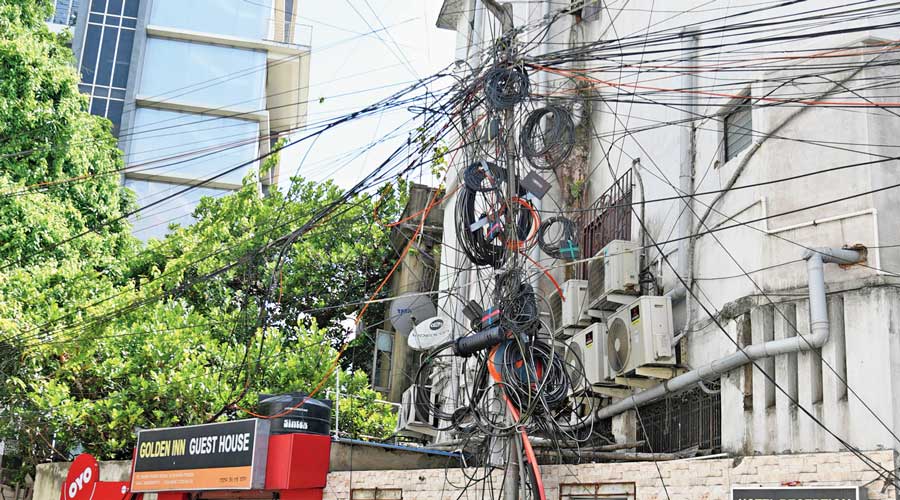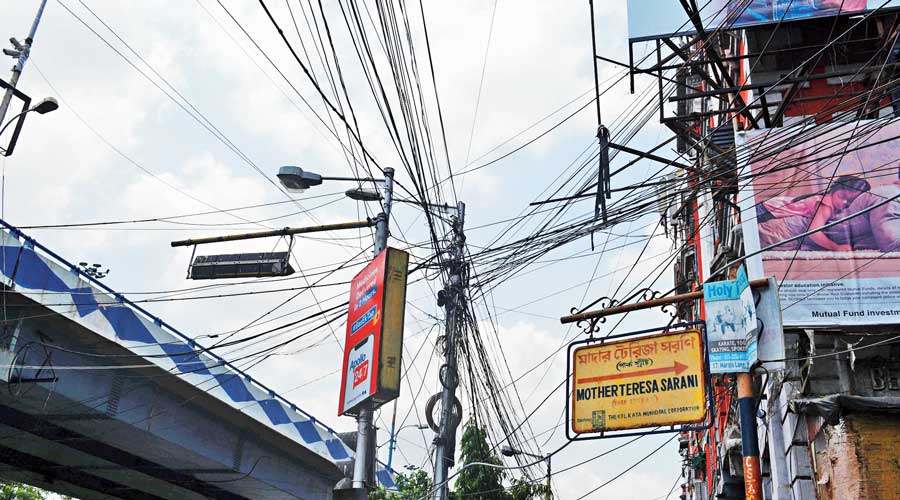Meshes of wires dangling from electric poles, choked gully pits and congested drains across Calcutta show very few lessons have been learnt from Cyclone Amphan, which had ravaged the city this time last year.
The only positive — the Calcutta Municipal Corporation convened meetings with CESC and disaster management agencies throughout Thursday. The approach was different from last year — 36 hours had passed after Amphan when the CMC convened a coordination meeting to restore normality in the city.
Personnel of the National Disaster Response Force will be kept on high alert from May 25, a day before the cyclone is tipped to hit land, officials said.
The coastal districts of Gangetic Bengal are set to get rainfall, accompanied by gusts of wind, from May 25 as Cyclone Yaas nears the Bengal coast, the Met office said on Friday. “The system is tipped to intensify into a cyclone by May 24 and reach the Bengal-Odisha coast by the morning of May 26,” said the official.
The Telegraph takes stock of the preparedness:
Fallen trees
Uprooted trees had emerged as the biggest hurdle to restoring normal life in the aftermath of Amphan. Engineers of power utilities had said fallen trees had delayed work on repairing or replacing damaged or snapped cables.
This time, the civic body has claimed to have ramped up their personnel and machines.
“Each of the 16 boroughs will have three emergency response teams. We are also trying to have a group of tree cutters in each of the 144 wards. The number of men deployed will be close to three times more than last year,” said Debasish Kumar, a member of the board of administrators of the CMC.
The stock of saws, ladders, JCB cranes and payloaders — needed to cut trees and remove debris — has also been ramped up significantly, he said, without going into specifics.
Another CMC official said they were trying to identify spots to dump the debris. “We will keep a pool of trucks on standby to ferry the debris if our vehicles fall short.”
Poles and cables
The CMC estimated that thousands of electric poles were uprooted across the city during Amphan. Engineers had attributed the high count of electric poles felled to the weight of cables on them, many of them defunct.
A trip across the city on Thursday and Friday showed little had changed. From Elgin Road to Ballygunge Circular Road, thick meshes of wires hanging from poles made their way through the canopy of trees — the perfect recipe for a rerun of last year’s disaster.
The cables included power, broadband and cable TV wires.

Meshes of wires on Sarat Bose Road. Pradip Sanyal and Gautam Bose
Cable operators and internet and telecom service providers attended a meeting called by the CMC on Friday. The operators have been asked to snip dead cables from poles to the “maximum extent possible” in three days, said a CMC official.
“We will start work tomorrow,” said Tapash Das, the joint convenor of the All Bengal Cable Television and Broadband Operators United Forum.
The civic body has in the past prodded MSO operators to snip dud cables to decongest the poles.
Power
A CESC spokesperson spoke of improved coordination and ramped-up manpower. The fleet of emergency response units of the power utility had depleted last year because the lockdown forced many workers to return home to districts or neighbouring states.
“We have more than doubled the number of specialised workers who will attend to snapped power lines. The coordination with the CMC has started early. If the fallen trees and branches are removed promptly, we will do our best to restore power supply as soon as possible,” he said.
He said the stock of generators, poles, cables and other equipment was being ramped up as well.
The utility serves over three million consumers in Calcutta and adjoining districts. Continuing power outage in the aftermath of Amphan had triggered protests in many areas.
Some areas like parts of Behala, Budge Budge, Panchashayar, Garia, Serampore and Baguiati are still dependent on an overhead network, which is more vulnerable to a storm. The CESC spokesperson said “around 80 per cent of the places under its jurisdiction had underground networks”.
Asked if any conversion — from overhead to underground network — had happened since Amphan, the spokesperson said: “It is a continuous process. Even in overhead network areas damaged by Amphan, we have set up completely new sets of equipment”.
“We are also focusing on a decentralised emergency response system for improved mobility,” he said.
Water
Water supply, which was hit for days in many areas after Amphan, is among the topmost priorities this time, CMC and CESC officials said.
The civic body is banking on a “sufficient stock” of generators to ensure water supply is not crippled.
“We will have generator back-up at all water treatment plants. We will also hire as many generators as we can from private suppliers in each ward. These will be provided to households with pumps but without power,” said Tarak Singh, a member of the board of administrators of the CMC.
“All 74 booster pumping stations will be functional and will have generator back-up. But if the rain coincides with the high tide in the Hooghly and the closure of lock gates, waterlogging is inevitable,” said a CMC official.
He said work had started to clear the mouth of many choked gully pits in the city.
The civic body has also ramped up the number of people who clean the mouth of gully pits on flooded roads so the accumulated water can flow into the underground drainage network. The men will also open man-hole covers to quickly drain out water, said the official.

